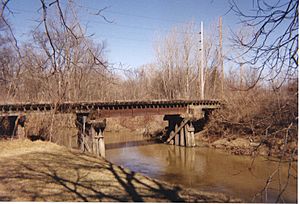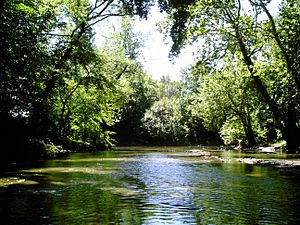Cedar Creek (Indiana) facts for kids

Cedar Creek is a special river in northeastern Indiana. Native Americans, like the Miami people, called it Mes-kwah-wa-se-pe, which means "old redwood creek." It's the biggest stream that flows into the St. Joseph River. Cedar Creek helps drain a huge area of land, about 174,780 acres (or 707 square kilometers), in a farming region called the Eastern Corn Belt Plains.
The creek is about 31.9 miles (51.3 kilometers) long. It starts in the northwestern part of DeKalb County and then joins the St. Joseph River near the Cedarville Dam in Allen County.
How Cedar Creek Was Formed
Cedar Creek has a very interesting past, shaped by ancient glaciers! Long, long ago, during the Ice Age, a giant sheet of ice called the Wisconsin Glacier covered much of the land. The upper part of Cedar Creek began as a channel along the edge of this ice.
Back then, the upper Cedar Creek was actually connected to another river called the Eel River. The Eel River flowed southwest and eventually joined the Wabash River. But the lower part of Cedar Creek was different. It flowed under the ice through a hidden tunnel, carrying melted glacier water. This tunnel is now known as Cedar Creek Canyon.
Over time, something amazing happened. Melted ice and dirt from the canyon blocked the Eel River's path. As the glaciers melted, there was less water flowing. This caused the lower Cedar Creek to change direction and flow the other way! When it reversed, it "captured" the water from the upper Eel River. This is a cool natural event called stream piracy. Because of this, Cedar Creek's water, which used to flow into the Eel-Wabash river system, now flows into the St. Joseph-Maumee system instead.
In the early 1900s, parts of upper Cedar Creek were straightened and deepened. This was done to help drain water from farms and towns. While it helped with drainage, it also made the land around the creek more likely to erode (wear away) and allowed polluted water to run into the creek. Cedar Creek used to be home to 27 different kinds of freshwater mussels, but sadly, their numbers have gone down a lot since the 1980s.
Where Cedar Creek Flows
Cedar Creek officially begins at Cedar Lake, which is downstream from Indian Lake (located at 41º27'51" N 85º10'11" W), northwest of Corunna, Indiana.
In DeKalb County, the creek flows east-southeast from Indian Lake. It then makes a loop around Waterloo and passes through Auburn. After Auburn, it turns southwest until it reaches Allen County. Here, Indiana State Road 327 crosses over it south of Garrett. Finally, it turns southeast again, heading towards Leo-Cedarville.
The lower part of Cedar Creek, from about 13.7 miles (22 kilometers) upstream to where it joins the St. Joseph River, is very special. It's officially called an "Outstanding State Resource Water." This means it's one of only four streams in Indiana that are part of the state's Natural, Scenic and Recreational Rivers system, recognized for its beauty and importance.
Tributaries of Cedar Creek
Many smaller streams and ditches flow into Cedar Creek, adding to its water. These are called tributaries. Some of the main ones include:
- Willow Creek
- Yant Ditch
- Little Cedar Creek
- Schmadel Ditch
- Dosch Ditch
- Garrett City Ditch
- Diehl Ditch
- W Smith Ditch
- Matson Ditch
- Swartz Ditch
- Dibbling Ditch
- Cedar Lake (which has its own smaller streams flowing into it)



